1996 BUICK REGAL oil temperature
[x] Cancel search: oil temperaturePage 79 of 356
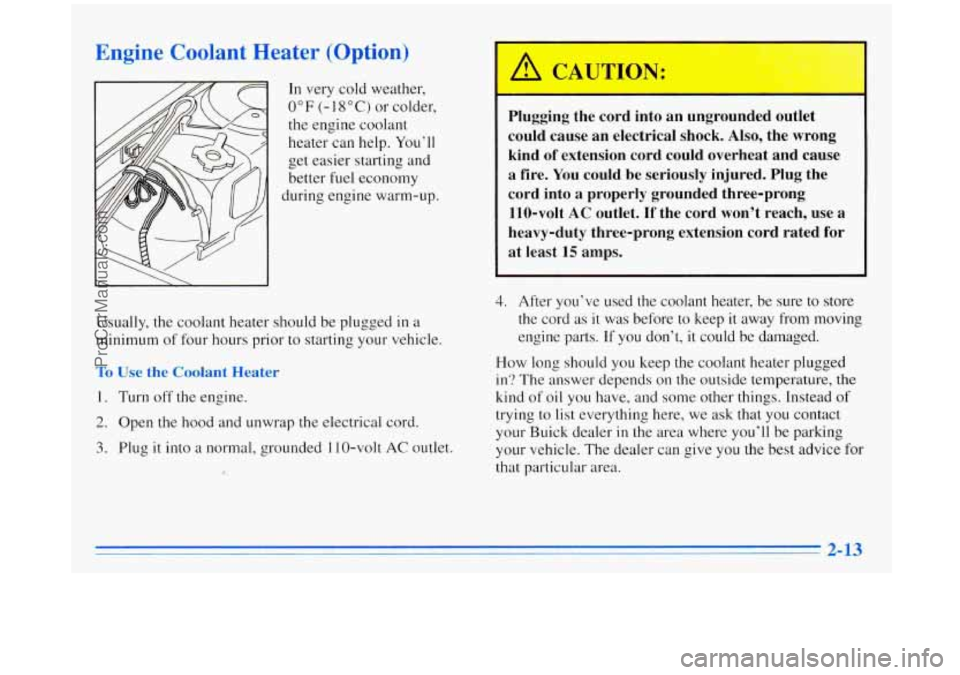
Engine Coolant Heater (Option)
In very cold weather,
0°F (-1 8°C) or colder,
the engine coolant
heater can help. You’ll
get easier starting and
better fuel economy
during engine warm-up.
Usually, the coolant heater should be plugged
in a
minimum of four hours prior to starting your vehicle.
To Use the Coolant Heater
I. Turn off the engine.
2. Open the hood and unwrap the electrical cord.
3. Plug it into a normal, grounded 110-volt AC outlet.
Plugging the cord into an ungrounded outlet
could cause an electrical shock.
Also, the wrong
kind
of extension cord could overheat and cause
a fire. You could be seriously injured. Plug the
cord into a properly grounded three-prong
110-volt
AC outlet. If the cord won’t reach, use a
heavy-duty three-prong extension cord rated for
at least
15 amps.
4. After you’ve used the coolant heater, be sure to store
the cord as it was before to keep it away from moving
engine parts.
If you don’t, it could be damaged.
How long should
you keep the coolant heater plugged
in? The answer depends on the outside temperature,
the
kind of oil you have, and some other things. Instead of
trying to list everything here, we ask that you contact
your Buick dealer
in the area where you’ll be parking
your vehicle. The dealer can give you the best advice for
that particular area.
ProCarManuals.com
Page 235 of 356
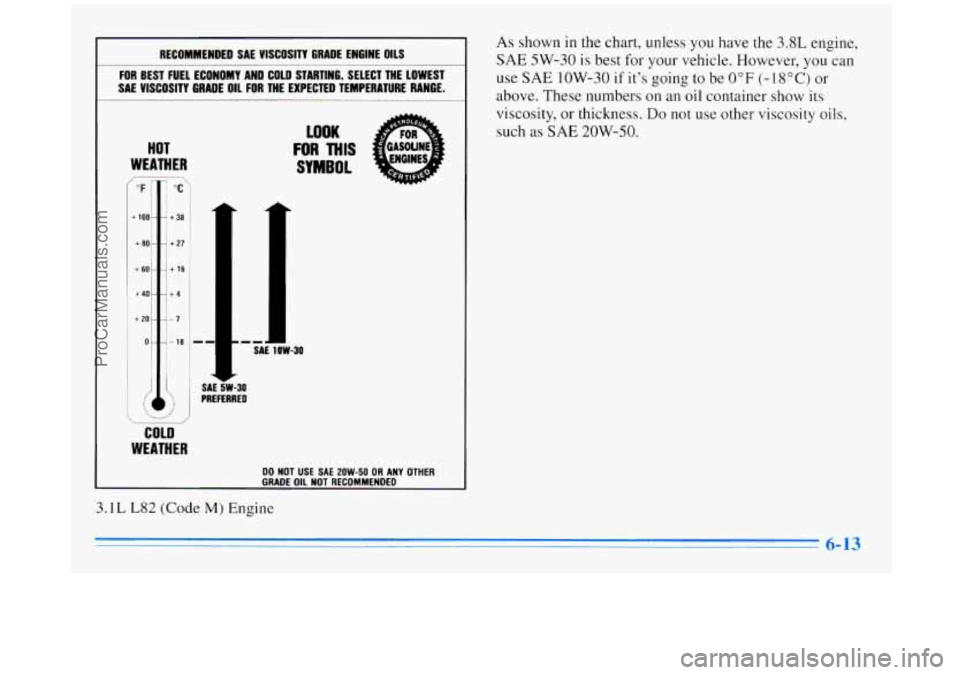
RECOMMENDED SAE VISCOSITY GRADE ENGINE OILS
FOR BEST FUEL -------ylY AND COLD STARTING, SELECT THE LOWEST
SAL VlSCOSlTV
bnmws DIL FOR THE EXPECTED TEMPERATURE RANGE. -
HOT
WEATHER
LOOK
FOR THIS
SYMBOL
"F
4- 100
+ 801
t 60.
+ 40-
t 20
0.
j
,
+ 16
i4
-7
COLD
WEATHER
SAE CW-30 PREFERRED
00 NOT USE SAE 2OW-50 OR ANY OTHER
GRADE OIL NOT RECOMMENDED
3.1 L L82 (Code M) Engine
As shown in the chart, unless you have the 3.8L engine,
SAE 5W-30 is best for your vehicle. However, you can
use SAE low-30 if it's going to be 0°F (-18°C) or
above. These numbers on an oil container show its
viscosity, or thickness.
Do not use other viscosity oils,
such as SAE 20W-50.
ProCarManuals.com
Page 236 of 356
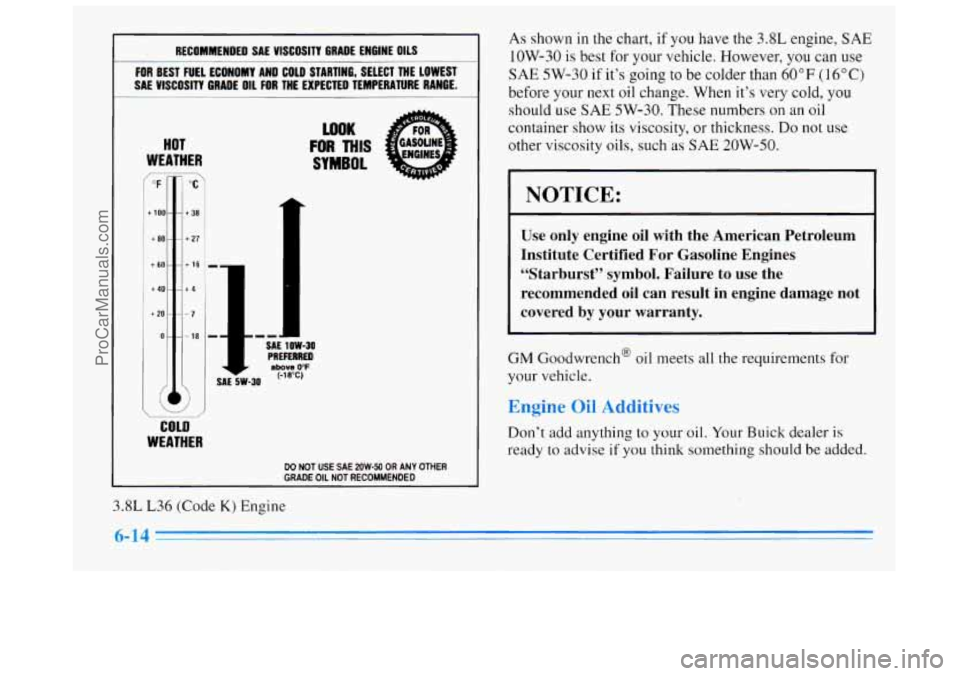
RECOMMENDED SAE VISCOSITY GRADE ENGINE OILS
FOR BEST FUEL r---'--lY AND COLD STARTING, SELECT THE LOWEST
SAE
VISCOSITY G...."- ,I1 FOR THE EXPECTED TEMPERATURE RANGE.
HOT
WEATHER
- "F "C
+loo- - +38
+eo- - +27
+60--+16
t40--+4
t20---7
0---18
/
WOK
FOR MIS
SYMBOL
'I I I--
SAE 1OW-3fl PREFERRED above 0°F
SAE 5W-30 (-1eOc)
COLD
WEATHER
DO NOT USE SAE 2OW-50 OR ANY OTHER
GRADE OIL NOT RECOMMENDED
As shown in the chart, if you nave the 3.8L engine, SAE
low-30 is best for your vehicle. However, you can use
SAE 5W-30 if it's going to be colder than 60°F (16°C)
before your next oil change. When it's very cold, you
should use
SAE 5W-30. These numbers on an oil
container
show its viscosity, or thickness. Do not use
other viscosity oils, such as
SAE 20W-50.
NOTICE:
Use only engine oil with the American Petroleum
Institute Certified For Gasoline Engines "Starburst" symbol. Failure to use the
recommended oil can result in engine damage not
covered by your warranty.
GM Goodwrench@ oil meets all the requirements for
your vehicle.
1 .ILIVC
Don't add anything to your oil. Your Buick dealer is
ready to advise
if you think something should be added.
3.8L L36 (Code
K) Engine
ProCarManuals.com
Page 237 of 356
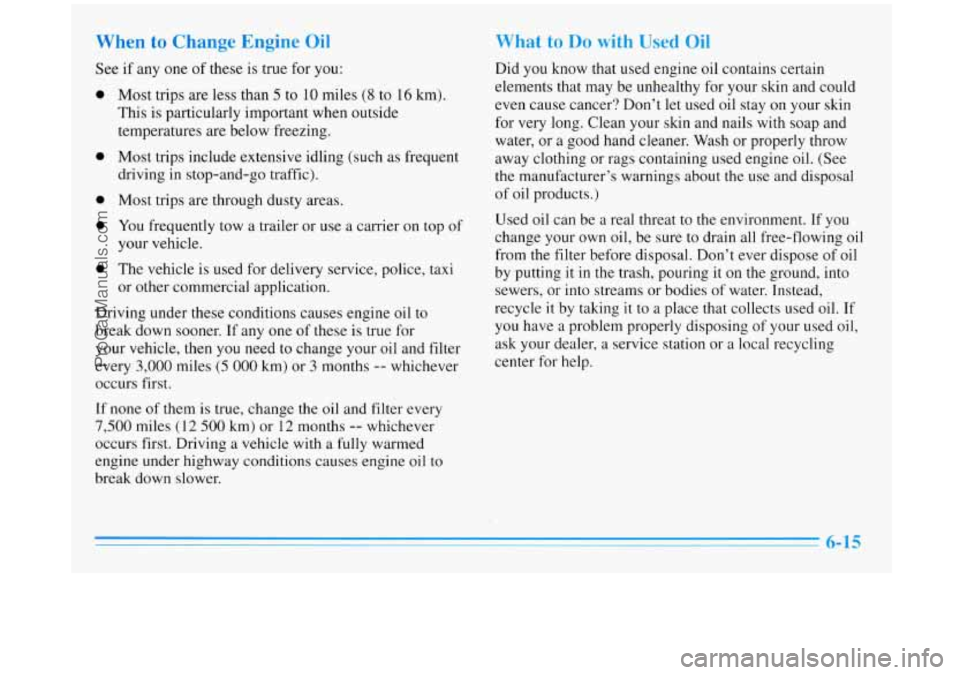
When to Change Engine Oil
See if any one of these is true for you:
0
0
0
0
0
Most trips are less than 5 to 10 miles (8 to 16 km).
This is particularly important when outside
temperatures are below freezing.
Most trips include extensive idling (such as frequent
driving in stop-and-go traffic).
Most trips are through dusty areas.
You frequently tow a trailer or use a carrier on top of
your vehicle.
The vehicle is used for delivery service, police, taxi
or other commercial application.
Driving under these conditions causes engine oil
to
break down sooner. If any one of these is true for
your vehicle, then
you need to change your oil and filter
every
3,000 miles (5 000 km) or 3 months -- whichever
occurs first.
If none
of them is true, change the oil and filter every
7,500 miles (12 500 km) or 12 months -- whichever
occurs first. Driving a vehicle with a fully warmed
engine under highway conditions causes engine oil to
break down slower.
What to Do with Used Oil
Did you know that used engine oil contains certain
elements that may be unhealthy for your skin and could
even cause cancer? Don’t let used oil stay
on your skin
for very long. Clean your skin and nails with soap and
water, or a good hand cleaner. Wash or properly throw
away clothing
or rags containing used engine oil. (See
the manufacturer’s warnings about the use and disposal
of oil products.)
Used oil can be a real threat
to the environment. If you
change your own oil, be sure to drain all free-flowing oil
from
the filter before disposal. Don’t ever dispose of oil
by putting it in the trash, pouring it on the ground, into
sewers, or into streams or bodies of water. Instead,
recycle it by taking
it to a place that collects used oil. If
you have a problem properly disposing of your used oil,
ask your dealer, a service station or a local recycling
center for help.
6-15
ProCarManuals.com
Page 239 of 356
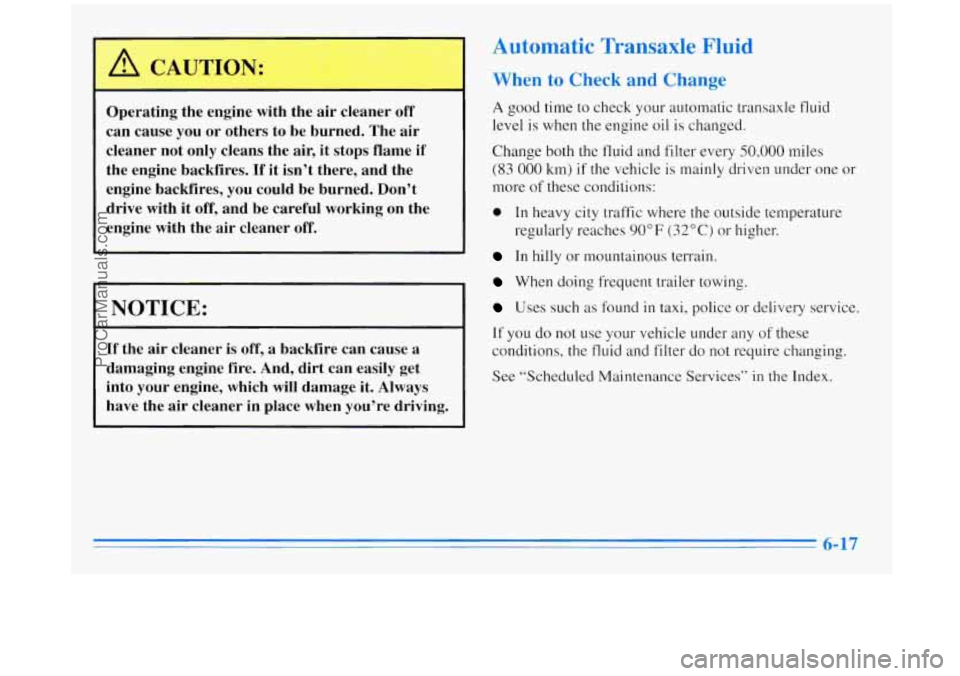
L
Operating the engine with the air cleaner off
can cause you or others to be burned. The air
cleaner not only cleans the air, it stops flame if
the engine backfires.
If it isn’t there, and the
engine backfires, you could be burned. Don’t
drive with it
off, and be careful working on the
engine with the air cleaner
off.
NOTICE:
If the air cleaner is off, a backfire can cause a
damaging engine fire. And, dirt can easily get into your engine, which will damage it. Always
have the air cleaner in place when you’re driving.
Automatic Transaxle Fluid
When to Check and Change
A good time to check your automatic transaxle fluid
level is when the engine
oil is changed.
Change both the fluid and filter every
50,000 miles
(83 000 km) if the vehicle is mainly driven under one or
more of these conditions:
0 In heavy city traffic where the outside temperature
regularly reaches
90°F (32°C) or higher.
In hilly or mountainous ten-ain.
When doing frequent trailer towing.
Uses such as found in taxi, police or delivery service.
If you do not use your vehicle under any of these
conditions, the fluid and filter do not require changing.
See “Scheduled Maintenance Services”
in the Index.
6-17
ProCarManuals.com
Page 242 of 356
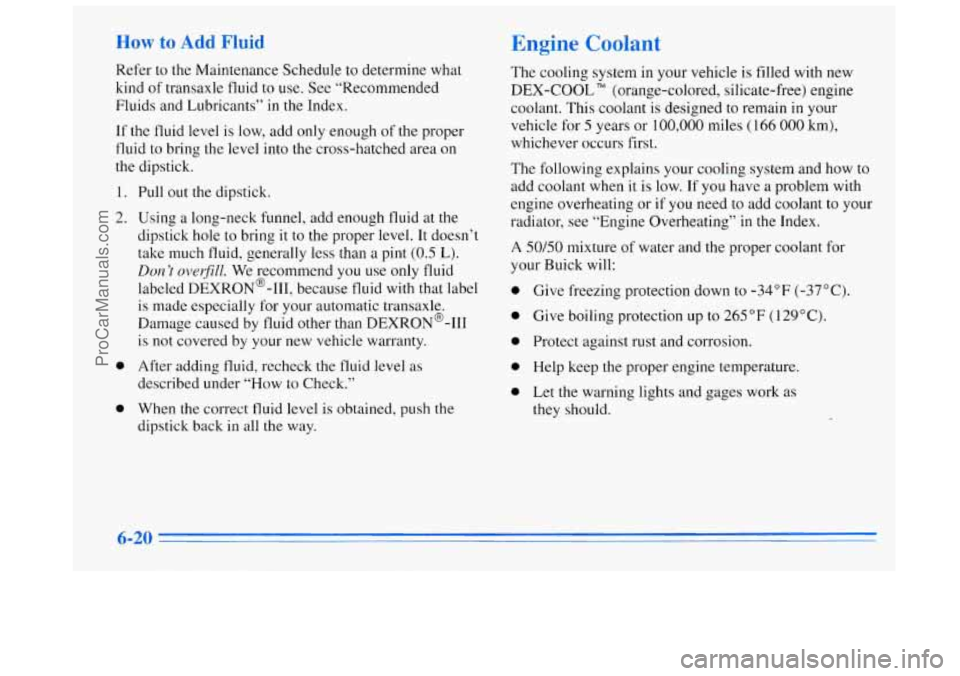
How to Add Fluid
Refer to the Maintenance Schedule to determine what
kind
of transaxle fluid to use. See “Recommended
Fluids and Lubricants’’
in the Index.
If the fluid level is low, add
only enough of the proper
fluid to bring the level into the cross-hatched area on
the dipstick.
1.
2.
0
0
Pull out the dipstick.
Using
a long-neck funnel, add enough fluid at the
dipstick hole to bring
it to the proper level. It doesn’t
take much fluid, generally less than a pint
(0.5 L).
Don t overfill. We recommend you use only fluid
labeled DEXRONO-111, because fluid with that label
is made especially for your automatic transaxle.
Damage caused by fluid other than DEXRON@-I11
is not covered by your new vehicle warranty.
After adding fluid, recheck the fluid level
as
described under “How to Check.”
When
the correct fluid level is obtained, push the
dipstick back in all the way.
Engine Coolant
The cooling system in your vehicle is filled with new
DEX-COOL
TM (orange-colored, silicate-free) engine
coolant. This coolant
is designed to remain in your
vehicle for
5 years or 100,000 miles (166 000 km),
whichever occurs first.
The following explains your cooling system and how to
add coolant when
it is low. If you have a problem with
engine overheating or
if you need to add coolant to your
radiator, see “Engine Overheating” in the Index.
A 50/50 mixture of water and the proper coolant for
your Buick will:
Give freezing protection down to
-34°F (-37°C).
Give boiling protection up
to’ 265 “F ( 129” C).
Protect against rust and corrosion.
Help keep the proper engine temperature.
Let the warning lights and gages work as
they should.
ProCarManuals.com
Page 290 of 356

Maintenance Schedule
I Short Trip/City Defition I
Follow the Short Trip/City Maintenance Schedule if any
one
of these conditions is true for your vehicle:
Most trips are less than 5 to 10 miles (8 to 16 km).
This is particularly important when outside
temperatures
are below freezing.
0 Most trips include extensive idling (such as frequent
driving
in stop-and-go traffic).
0 Most trips are through dusty areas.
0 You frequently tow a trailer or use a carrier on top
of your vehicle.
0 If the vehicle is used for delivery service, police,
taxi, or other commercial application.
One of the reasons you should follow this schedule if you
operate your vehicle under any of these conditions is that
these conditions cause erzgirze oil to break down soonex
Short Trip/City Intervals
Every 3,000 Miles (5 000 km): Engine Oil and Filter
Change (or
3 months, whichever occurs first).
Every 6,000 Miles (10 000 km): Chassis Lubrication
(or
6 months, whichever occurs first).
At 6,000 Miles (10 000 km) - Then Every
12,000 Miles (20 000 km): Tire Rotation.
Every 15,000 Miles (25 000 km): Air Cleaner Filter
Inspection, if driving
in dusty conditions.
Every 30,000 Miles (50 000 km): Air Cleaner Filter
Replacement.
Fuel Tank, Cap and Lines Inspection.
Every 50,000 Miles (83 000 km): Automatic Transaxle
Service (severe conditions only).
Every 60,000 Miles (100 000 km): Engine Accessory
Drive Belt Inspection.
Every 100,000 Miles (166 000 km): Cooling System
Service (or every
60 months, whichever occurs first).
Spark Plug Wire Inspection. Spark Plug Replacement.
These ilztervnls on.ly summarize mainteuance services.
Be sure to follow th.e complete maintenance schedule on
the following pages.
7-4
ProCarManuals.com
Page 301 of 356
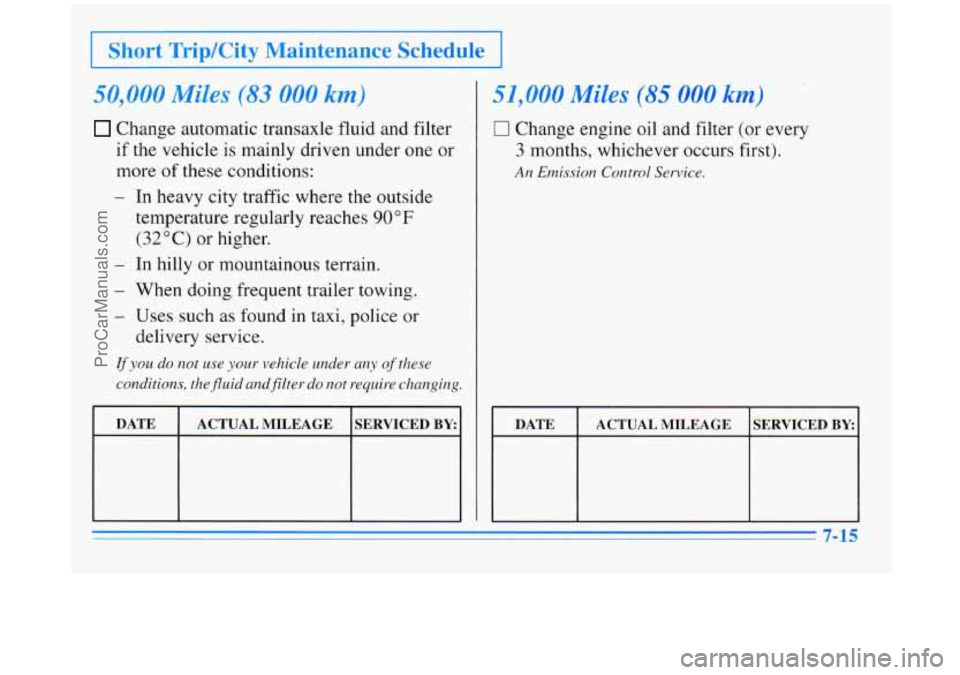
Short Trip/City Maintenance Schedule
50,000 Miles (83 000 km)
Change automatic transaxle fluid and filter
if the vehicle is mainly driven under one or
more of these conditions:
- In heavy city traffic where the outside
temperature regularly reaches
90 OF
(32°C) or higher.
- In hilly or mountainous terrain.
- When doing frequent trailer towing.
- Uses such as found in taxi, police or
delivery service.
If you do not use your vehicle under any of these
conditions, the fluid and.filter do
not require changing.
I DATE I ACTUAL MILEAGE SERVICED BYI
51,000 Miles (85 000 km)
0 Change engine oil and filter (or every
3 months, whichever occurs first).
An Emission Control Service.
DATE SERVICED BY ACTUAL MILEAGE
7-15
ProCarManuals.com